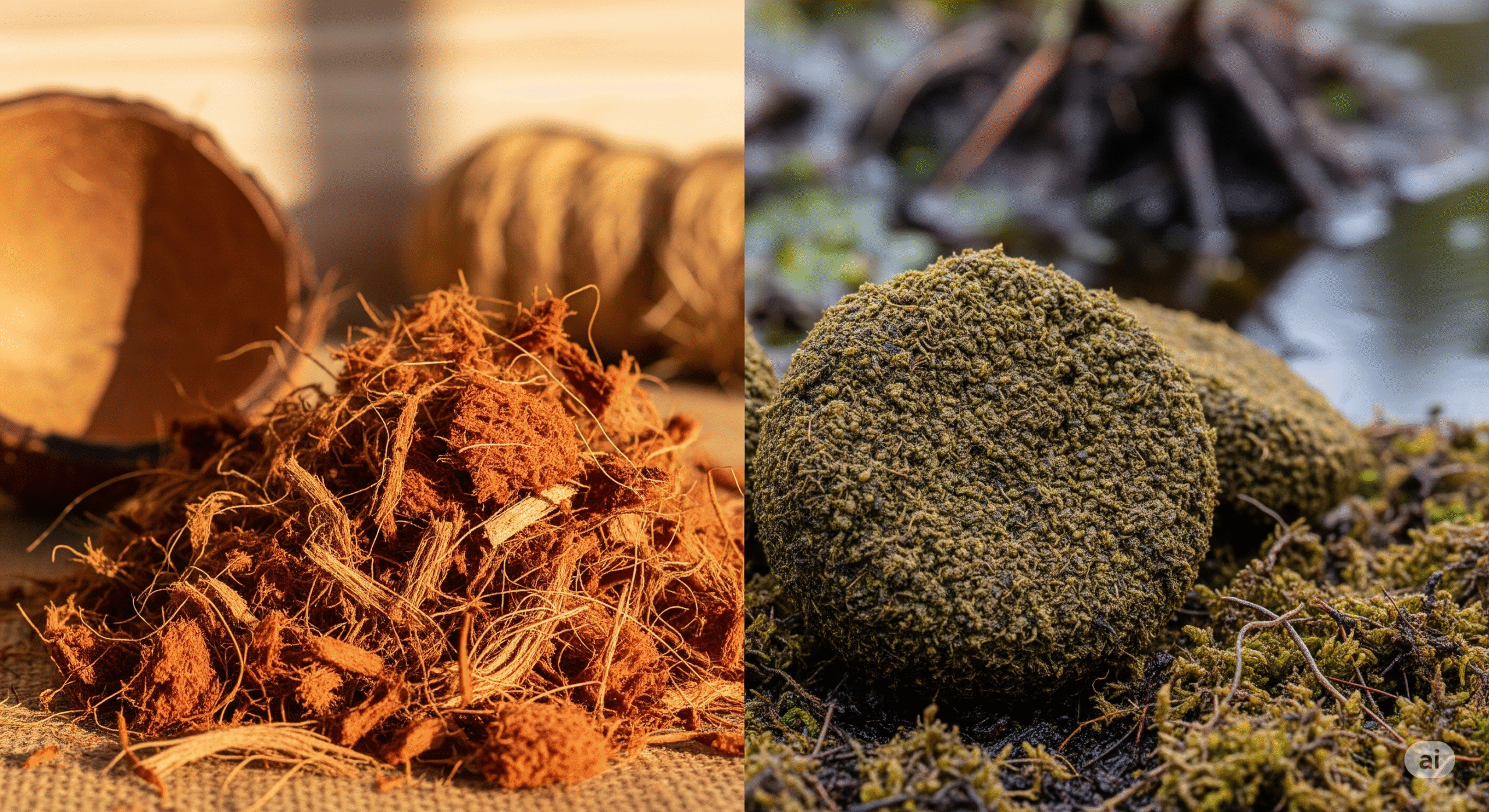1. Introduction
As global agriculture shifts toward more sustainable practices, the demand for soil alternatives that balance environmental responsibility with high performance is rapidly increasing. Traditional options such as peat moss are under growing scrutiny due to their environmental impact, while synthetic media raise concerns about chemical residues and long-term soil health.
Cocopeat, also known as coco coir or coir pith, is emerging as a compelling solution. Derived from the husk of coconuts, this once-overlooked byproduct of the coconut industry is now recognized for its value in sustainable farming and export-focused agriculture.
But what makes cocopeat stand out among other growing mediums? And why is it being embraced as the best soil alternative for export-oriented agricultural systems?
This blog explores the answer through three core pillars that define cocopeat’s value:
- Sustainability: A renewable, biodegradable material with minimal environmental impact
- Agronomic performance: High water retention, balanced aeration, and ideal pH characteristics
- Export readiness: Lightweight, pest-free, and adaptable to diverse growing systems
Together, these qualities position cocopeat not only as an alternative to traditional media but as a smarter, cleaner, and more scalable solution for the future of agriculture.
2. Cocopeat: A Sustainable Game-Changer
Cocopeat stands out among soil alternatives because of its strong environmental credentials. As sustainable agriculture becomes a global priority, cocopeat offers a practical, scalable, and environmentally responsible solution.
One of its key advantages is its origin. Cocopeat is a byproduct of the coconut industry, produced from the fibrous husk that surrounds the coconut shell. Instead of being discarded as waste, these husks are processed into a high-quality growing medium. This repurposing reduces agricultural waste and supports a more circular, low-impact production system.
In contrast to peat moss, which is harvested from ecologically sensitive peat bogs, cocopeat production does not involve the destruction of natural habitats. It avoids releasing stored carbon, preserving biodiversity and maintaining the integrity of vital ecosystems.
Cocopeat is also fully biodegradable. It breaks down naturally in the soil without leaving behind harmful residues. This characteristic reduces the risk of long-term soil contamination and supports healthier soil biology over time.
Thanks to the widespread cultivation of coconuts, particularly in tropical regions, there is a consistent and renewable supply of raw material. This makes cocopeat a dependable option for both local use and large-scale agricultural exports.
Cocopeat is not just a sustainable alternative. It is a forward-thinking solution that meets the demands of responsible farming practices without compromising environmental integrity.
3. Agronomic Advantages That Matter
Beyond its sustainability benefits, cocopeat offers a range of agronomic advantages that make it highly effective as a growing medium. These physical and chemical properties directly support healthy plant growth and simplify crop management across diverse agricultural systems.
One of the most important features of cocopeat is its exceptional water retention capacity. It can absorb and hold up to eight to nine times its weight in water, ensuring consistent moisture availability to plant roots. This reduces the need for frequent irrigation and helps buffer against periods of drought or irregular watering schedules.
At the same time, cocopeat maintains excellent drainage and aeration. Its fibrous, open structure allows excess water to drain easily while promoting airflow to plant roots. This combination prevents waterlogging and root rot, two common issues in poorly draining soils, and supports robust root development.
Cocopeat also has a naturally balanced pH, typically ranging from 5.5 to 6.5. This near-neutral pH level makes it suitable for a wide variety of crops without the need for significant amendments. Farmers and growers can use cocopeat with minimal chemical inputs, making it both cost-effective and environmentally safer.
These agronomic strengths make cocopeat highly versatile. It performs well in hydroponic systems, seed starting trays, potting mixes, and large-scale horticultural operations. Whether used on its own or blended with other materials, cocopeat provides a stable, high-performing foundation for healthy plant growth.
In practical terms, cocopeat supports higher yields, reduces input costs, and simplifies cultivation all while maintaining a natural, soil-friendly profile.
4. Export-Ready and Globally Adaptable
Cocopeat is not only a sustainable and agronomically sound choice, but it is also uniquely suited for international export. Its physical properties, ease of handling, and compliance with global agricultural standards make it a top-tier product for commercial distribution across borders.
One of cocopeat’s key logistical advantages is its form. It is typically compressed into lightweight blocks or bricks, which significantly reduces volume during shipping and storage. This compression translates into lower transportation costs and more efficient handling, a critical factor for exporters operating in competitive markets.
Another major benefit is its phytosanitary quality. Properly processed cocopeat is free from weed seeds, pests, and pathogens. This makes it compliant with strict import regulations in countries with high agricultural standards. Its clean, inert nature minimizes the risk of introducing foreign organisms, which is essential in maintaining biosecurity.
Cocopeat’s adaptability also enhances its global appeal. It can be used in a wide range of agricultural and horticultural applications, including hydroponics, seed propagation, potting mixes, greenhouses, and nursery substrates. This flexibility allows exporters to serve diverse markets and meet the needs of different farming systems around the world.
As more countries prioritize environmentally responsible farming and look for safe, reliable imports, cocopeat offers a proven solution that aligns with both market demands and sustainability goals.
5. Final Verdict: Why Cocopeat Wins for Export Agriculture
Cocopeat has earned its place as the leading sustainable soil alternative for export by offering a rare combination of environmental responsibility, agronomic performance, and global market readiness. It turns an agricultural byproduct into a high-value resource, supports healthier and more efficient crop production, and meets the strict standards required for international trade.
Its sustainability is rooted in circular production and minimal ecological impact. Its physical qualities, high water retention, excellent aeration, and balanced pH make it ideal for a wide range of crops and growing environments. Its compressed, pest-free form ensures smooth logistics and regulatory compliance, opening doors to export markets around the world.
For producers and exporters looking to align with the future of agriculture, cocopeat is more than just an alternative. It is a strategic, scalable, and eco-conscious solution that delivers results without compromising on environmental values.
Choosing cocopeat is not only a smart business decision, it is a commitment to a more sustainable and globally connected agricultural system.
Most Asked Questions About Cocopeat
1. What is cocopeat and why is it used in agriculture?
Cocopeat is a natural growing medium made from the fibrous husk of coconuts. It is used in agriculture for its excellent water retention, aeration, and biodegradable nature, making it a sustainable alternative to traditional soil amendments.
2. Is cocopeat better than peat moss?
Cocopeat is considered more environmentally friendly than peat moss. While both improve soil structure and moisture retention, cocopeat is a renewable byproduct and does not harm natural habitats during harvesting, unlike peat moss.
3. Can cocopeat be used for all types of plants?
Yes. Cocopeat is highly versatile and suitable for a wide range of plants, including vegetables, flowers, herbs, and hydroponic crops. Its near-neutral pH and moisture-regulating properties support healthy root development across plant types.
4. How is cocopeat prepared for export?
For export, cocopeat is usually compressed into bricks or blocks to save space and reduce shipping costs. It is also washed and treated to ensure it is free from pests, weeds, and pathogens, making it compliant with international phytosanitary standards.
5. Is cocopeat reusable?
Cocopeat can be reused across multiple growing cycles, especially in controlled environments like greenhouses or hydroponics. However, it should be properly cleaned and monitored for degradation to maintain performance and plant health.


